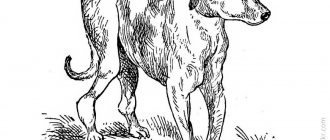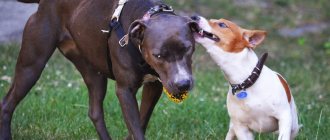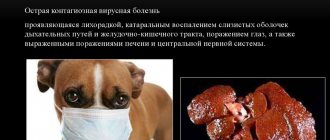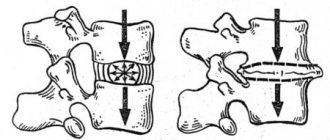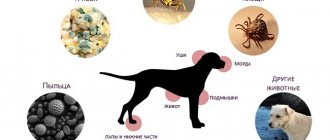Respiratory system of dogs
The dog's respiratory system is complex and consists of several parts, including the lungs and airways (larynx, trachea, nasal cavity and oral cavity). Diseases in any part of this system can cause rapid breathing in dogs.
Heavy breathing is called dyspnea, increased inspiratory amplitude is called hyperpnea, and excessively rapid breathing is called tachypnea.
Increased breathing can occur in dogs of any breed or age, but they are especially common in breeds with a flattened muzzle, narrow nostrils and an elongated soft palate, soft tracheal walls:
- French bulldogs and pugs.
- some of the toy breeds include Yorkshire terriers and Chihuahuas, as they are the most likely to suffer from hyperventilation problems.
Prevention
To make your pet happy and less sick, do not neglect preventive measures. That's why:
- visit the veterinary clinic regularly;
- take the necessary tests for infections;
- get the vaccinations your doctor recommends;
- Treat against helminths twice a year.
In addition, life and health are affected by the conditions in which he lives. Inflammatory or allergic diseases primarily appear in those dogs that live in drafts in damp, cool rooms. In autumn or spring, the animal may experience convulsive, rapid breathing, which will be accompanied by a cough.
Common Causes of Increased Breathing Rate in Dogs
- Infection (bacterial, viral, parasitic)
- Injury
- Bleeding
- Foreign objects in the respiratory tract
- Structural abnormality (eg, elongated soft palate)
- Heart failure
- Compression of the neck area, massive tumors
- Tracheal injury
- Anemia
- Allergies
- Pain
- Heat
- Diseases that are accompanied by an increase in abdominal volume (acute gastric dilatation, flatulence, ascites, massive neoplasms in the abdominal cavity)
- Medications
- Tumors
- Lung diseases (pneumonia, neoplasia, bronchitis, hemorrhage, thromboembolism, torsion of the lung lobe)
- Diseases of the pleura (pneumothorax, pleurisy, hydrothorax, chylothorax)
- Dirofilariasis
It can be difficult to determine whether your dog is breathing normally or not. Healthy dogs typically breathe at a rate of 20 to 35 breaths per minute, and their breathing should never be labored. If in doubt, contact your veterinarian or your nearest clinic.
Is my dog hyperventilating?
Rapid breathing in dogs can be caused by excitement or physical exertion. Dogs may also hyperventilate when they are afraid, stressed, or hot. Rapid breathing is one of the most important ways a dog can thermoregulate.
But be careful, rapid breathing is an early sign of heatstroke and should be carefully monitored at the appropriate time of year. If you are concerned that your dog has heatstroke, read the articles on our website.
Recognizing Abnormally High Breathing in Dogs
Your dog may show signs of drooling excessively and look like he is choking or stressed. She may also make loud breathing sounds such as snorting or grunting.
Another common sign of abnormal breathing is when your dog is panting heavily or rapidly, but is not hot or exercising. Heavy and rapid breathing in dogs should be of particular concern if their mouth is wide open and/or you can see their nostrils moving.
Dogs with rapid breathing and respiratory distress
They will also sometimes assume a forced standing posture or lie with their neck extended and elbows wide out to the sides - and they may become stressed if you try to interact with them. Check to see if their sides and belly are moving more noticeably and/or faster than usual, and pay special attention to the color of their tongue and gums. If they are an unusual color, especially if there is a bluish or blue-purple tint, contact your veterinarian immediately.
Difficult or rapid breathing in dogs is known as panting, while excessively rapid breathing is called tachypnea. Are you concerned about your dog's rapid breathing? Find your nearest clinic for immediate treatment.
What to do
If your dog's rapid breathing is the result of a medical condition, your veterinarian will recommend some medications to treat or treat the condition. However, there are several remedies for rapid breathing without any medical problems.
- If excessive heat is to blame, you can take your puppy indoors and turn up the air conditioning. The shortness of breath will not decrease immediately, but the dog's body temperature will certainly decrease. Cold water should also be available. If the dog is not cooled down immediately, it can result in heat stroke, which is fatal and can result in death in some cases. Never expose your puppy to very hot weather for too long or leave him locked in a hot car.
- In cases of anxiety or stress, dog parents usually find themselves in a helpless position, as there is little they can do. You can only be loving and gentle, taking the opportunity to bond with your new dog as you try to let him know that everything is okay and that you are there to protect and care for him. This is where treats come in handy. You can serve treats during vet visits, car rides, just to let them know that this new experience is nothing short of positive. Over time, your puppy will begin to associate these situations with dog treats, praise, and rewards, and the negative feelings will naturally subside.
- A remedy for stress is to give your dog plenty of water and take him to an air-conditioned room. You can also try to relax your dog temporarily by sitting him down before going out for the next play session, which is inevitable since puppies rarely rest.
- There is no cure for your puppy's rapid breathing during sleep. Just wait until the dog wakes up and everything will be normal again. It is not recommended to wake your puppy from sleep just because he is breathing quickly - this can lead to dog bites, as the shock of the sudden return to reality becomes overwhelming. The dog may forget who you are and act in self-defense, so it's best to let a sleeping dog sleep.
Causes of increased respiratory movements in dogs
Difficulty or rapid breathing, often called shortness of breath. This symptom may indicate insufficient oxygen in the bloodstream and is a life-threatening condition requiring emergency treatment.
The causes of rapid breathing in dogs are varied.
One of the most common in older animals is fluid accumulation in the lungs (heart failure) or chest cavity (a variety of causes). Pulmonary edema in dogs is often associated with heart and lung disease. Other less common causes of wheezing in dogs include foreign objects, lung cancer, infections such as pneumonia, chest wall injuries, kennel cough and allergies. Other diseases of the nose, larynx, airway (trachea), lungs and diaphragm (diaphragmatic hernia) can also cause this problem. High-rate breathing problems can also be a symptom of other serious problems, such as pain or metabolic problems.
First aid in case of pathology
If emergency transport to a veterinary clinic is not possible, place the animal in a cool place, providing sufficient oxygen. Try to call the veterinary clinic and clarify the names and dosages of drugs that can eliminate the existing symptoms.
“ Veterinarians recommend not to self-medicate until a diagnosis is made.
The only exception is providing first aid for cardiac arrest. It is easily identified by loss of consciousness, pallor of the mucous membranes and lack of reaction to light. It is possible to save the animal only in the first 2-3 minutes after the heartbeat stops. To do this, follow these steps:
- Turn your pet onto his right side and stretch his neck to ensure unimpeded passage of oxygen. The selected surface must be flat.
- Inhale more air and gradually exhale it directly into the dog’s nostrils. The smaller the animal, the shorter and shallower the inhalation should be.
- Place your hands on your ribs and make rhythmic pressing movements with a break of 5 seconds.
- Alternate cardiac massage and artificial respiration. For 2 breaths there should be 30 movements.
Continue the rescue operation for at least 10 minutes. Once the heartbeat returns, do not move the dog until veterinarians arrive.
Why is my dog breathing quickly?
Signs of breathing problems in dogs:
- Breathing from the stomach and chest
- Nostril flaring
- Open-mouth breathing or noisy breathing
- Breathing with the elbows moving away from the body
- The neck and head are kept low and extended in front of the body
- Noisy breathing (stridor - jamming on inspiration)
- Fast breathing
- Superficial
- Cough
Rapid breathing in dogs is not necessarily a sign of respiratory distress syndrome. If the dog is breathing quickly and shallowly, and its mouth is wide open with its tongue hanging out, tachypoiesis allows it to cool itself effectively.
However, if your dog is breathing heavily and quickly, with his mouth closed or only partially open, this could be a sign of something more serious and you should contact your veterinarian immediately.
Dangerous conditions
If the dog feels well and no additional symptoms occur, there is nothing to worry about.
Veterinary assistance will be required if the following signs are detected:
- cough, shortness of breath and fever;
- rapid breathing after whelping;
- the animal sits to facilitate breathing;
- the mouth is constantly open, inhalation occurs due to the tension of the abdominal muscles;
- impaired coordination of movement in the varnishing animal;
- the dog fusses, its tongue becomes purple or bluish;
- barking becomes hoarse;
- foam does not stop coming from the mouth;
- the pet whines when pressure is applied to the stomach.
If left untreated, a condition that threatens the pet's life occurs.
What does rapid breathing in a dog indicate?
When dogs breathe unusually quickly, they are said to be suffering from tachypnea.
Causes of tachypnea include lower respiratory tract problems such as bronchitis, pneumonia, hemorrhage in the lungs, or pulmonary edema, as well as non-respiratory problems such as anemia, heart disease and bloating. In some cases, tachypnea is also caused by stress, fear, fever, or fever. It should be kept in mind that rapid breathing can progress to shortness of breath, so it should never be ignored.
Therapy and home care
The method of treating a dog directly depends on the established cause of the breathing disorder. The main thing is to correctly follow the specialist’s instructions and come to your appointments on time. In advanced cases, the dog may be hospitalized.
In most cases, sedatives and oxygen therapy are required. When pulmonary edema is diagnosed, diuretics and anti-inflammatory drugs can be prescribed to relieve it. Infections are treated with antibiotics.
The speed and success of treatment directly depends on the strict adherence to the prescribed recommendations of the veterinarian. Make sure to take medications at the correct time and do not introduce new medications without the knowledge of your specialist. Always have clean drinking water available in an accessible place. Ventilate the room in a timely manner. After recovery, walks with your pet in the fresh air are mandatory.
My dog is having problems with a high breathing rate, what will the vet do?
The veterinarian will ask you about your dog's health, any signs of illness, and any possible incidents that may have caused them to have breathing problems. During the examination, your veterinarian will watch your dog's breathing and auscultate the chest to check for a heart murmur or wheezing or sloshing of fluid in the lungs.
The color of your dog's gums will also be assessed, as this may indicate the efficiency of oxygen delivery to the organs, or if the red blood cell count is very low (anemia). Your veterinarian may try to make your dog cough by touching his windpipe.
Treating Breathing Problems in Dogs
If your dog has real difficulty breathing
, a veterinarian or nurse may give her oxygen to help. In most cases, a blood test will also be needed to check for underlying health problems. The veterinarian may also perform chest x-rays and ultrasounds to examine the lungs and heart.
Treatment will depend on the nature of the symptoms and the diagnosis of the disease that led to increased breathing in dogs. In most cases, hospitalization will be required until your dog's breathing improves significantly.
^Top
Diagnosis of manifestations of dyspnea
First of all, all external irritants are excluded, it is important to exclude the pet from being in the heat, avoid stressful situations and unnecessary anxiety. At this stage, the main thing is not to delay visiting a specialist. This will avoid many serious problems.
To identify the causes of shortness of breath, the clinic prescribes a diagnostic examination of the whole body. A number of studies are carried out: chest x-ray, cardiogram, ultrasound, general tests and biochemical blood test. Only after reading all the results of the analysis is the correct diagnosis made and treatment prescribed.
When breathing is very difficult, the dog’s body is saturated with oxygen. This is done using oxygen masks or an oxygen chamber. To speed up the treatment process, the dog’s diet is additionally regulated with the addition of a vitamin complex to restore the level of hemoglobin in the blood.
